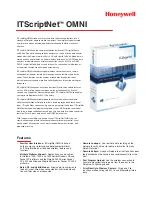
Glossary
332 User Manual CIE 1.0 System Administration
IP
IP stands for Internet Protocol. It is used to address and fragment data and transmit this
data to the recipient. It is a 32-bit address that is used to identify a node in an integrated
IP network. A unique IP address consisting of a network identifier and a host identifier
must be assigned to each node in an IP network. This address is normally transmitted
in dotted decimal point format, in which case the decimal value of each group of eight
digits is separated by a point, for example 192.168.7.27.
ISDN
ISDN stands for Integrated Services Digital Network. The Deutsche Bundespost
Telekom universal digital telephone network, which is under construction and has
developed from the digital telephone network. It comprises different data services. It is
internationally standardized and has been introduced in this form by almost all postal
services in the western world. It offers multiple telephone, data, text and image
communication via two 64 kbits/s user channels and a 16 kbits/s signaling channel for a
digital telephone connection (with a telephone number). Dial-up and dedicated
connections for multiple and mixed communication are possible. Currently new
terminals are being developed for ISDN including ISDN fax machines that can transfer
text and graphics in under 10 seconds per DIN A4 page during a telephone
conversation.
ISQL
ISQL stands for Interactive Structured Query Language.
IVR
IVR stands for Interactive Voice Response.
LAN
LAN stands for Local Area Network. A LAN is a group of computers, which are
interconnected in a network.
NTFS
NTFS stands for New Technology File System and is the file system of Windows NT
and its successors Windows 2000, Windows XP, Windows Server 2003, and Windows
Vista.
ODBC
ODBC stands for Open DataBase Connectivity. ODBC is a standardized database
interface that uses the SQL database language.
PBX
PBX stands for Private Branch eXchange (telecommunications system).
It is a device for connecting internal telephones to each other and to the public
telecommunications network. It can also have data transfer functions.
PCM
PCM stands for Pulse Code Modulation. It is a special modulation method that
digitalizes signals before modulation. In 1968, the CCITT introduced the PCM
30-channel time-division multiplex system with 30 digital voice channels with a transfer
speed of 2048 kbits/s. It also includes channel 0 for synchronization and channel 16 for
signaling information. Each channel has a 300 Hz to 3.4 kHz bandwidth, 8 kHz
sampling frequency and 8 bit sampling rate quantization.
PDF stands for Portable Document Format.
PTP
PTP stands for Point To Point.
POP3
POP3 stands for Post Office Protocol Version 3. POP3 is a line protocol by means of
which a client can retrieve e-mails from an e-mail server.
QSIG
QSIG stands for Q reference point signaling. In telecommunications QSIG is a signaling
protocol based on ISDN for networking PBXs.
Содержание Customer Interaction Express 1.0
Страница 3: ......
Страница 4: ......
Страница 22: ...22 User Manual CIE 1 0 System Administration...
Страница 84: ...84 User Manual CIE 1 0 System Administration...
Страница 131: ...Connecting to ACM Avaya Communication Manager Edition 1 1 03 08 2007 131...
Страница 154: ...154 User Manual CIE 1 0 System Administration...
Страница 174: ...174 User Manual CIE 1 0 System Administration...
Страница 216: ...216 User Manual CIE 1 0 System Administration...
Страница 226: ...226 User Manual CIE 1 0 System Administration...
Страница 318: ...318 User Manual CIE 1 0 System Administration...
Страница 322: ...322 User Manual CIE 1 0 System Administration...













































